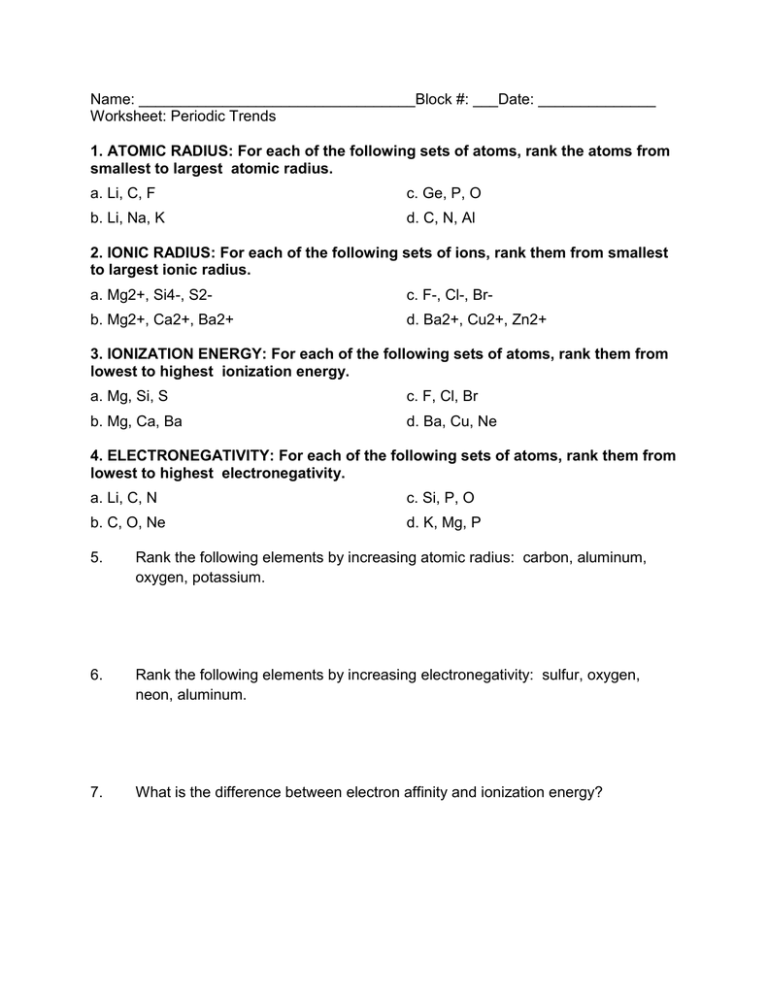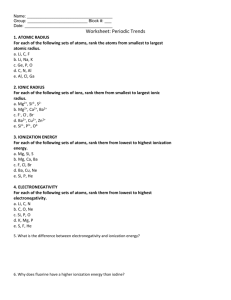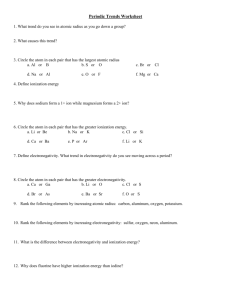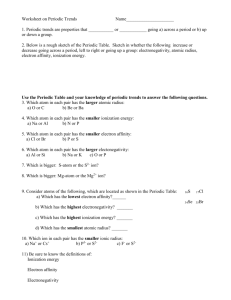Name: #: ___Date: Worksheet: Periodic Trends 1. ATOMIC RADIUS
advertisement

Name: _________________________________Block #: ___Date: ______________ Worksheet: Periodic Trends 1. ATOMIC RADIUS: For each of the following sets of atoms, rank the atoms from smallest to largest atomic radius. a. Li, C, F c. Ge, P, O b. Li, Na, K d. C, N, Al 2. IONIC RADIUS: For each of the following sets of ions, rank them from smallest to largest ionic radius. a. Mg2+, Si4-, S2- c. F-, Cl-, Br- b. Mg2+, Ca2+, Ba2+ d. Ba2+, Cu2+, Zn2+ 3. IONIZATION ENERGY: For each of the following sets of atoms, rank them from lowest to highest ionization energy. a. Mg, Si, S c. F, Cl, Br b. Mg, Ca, Ba d. Ba, Cu, Ne 4. ELECTRONEGATIVITY: For each of the following sets of atoms, rank them from lowest to highest electronegativity. a. Li, C, N c. Si, P, O b. C, O, Ne d. K, Mg, P 5. Rank the following elements by increasing atomic radius: carbon, aluminum, oxygen, potassium. 6. Rank the following elements by increasing electronegativity: sulfur, oxygen, neon, aluminum. 7. What is the difference between electron affinity and ionization energy? 8. Why does fluorine have a higher ionization energy than iodine? 9. Why do elements in the same family generally have similar properties? 10. Which group tends to form 1+ ions?__________________________________ 11. Which group tends to form 2+ ions?__________________________________ 12. Which group tends to form 1- ions?__________________________________ 13. Which group tends not to form ions or react?___________________________ 14. Locate the alkali metals, alkaline earth metals, halogens, noble gases, actinides, lanthanides, main group elements, semimetals (metalloids), transition metals and inner transition metals on the periodic table. 15. What repeating pattern is noticeable regarding the ionization energies of different elements? How does the periodic table account for this pattern? 16. Explain the pattern for electronegativity and atomic size from the periodic table. Based on the concept of periodic trends, answer the following questions for these atoms: Li, Be, Mg, Na. Be able to defend your answers. 17. Which element has the highest first ionization energy?___________________ 18. Which element has the lowest electronegativity?________________________ 19. Which element has the least metallic character?_________________________ 20. Which element is the largest atom?__________________________________ Based on the concept of periodic trends, answer the following questions for these atoms: P, S, Cl, F. Be able to defend your answers. 21. Which element has the highest first ionization energy?___________________ 22. Which element has the highest electronegativity?_______________________ 23. Which element has the least metallic character?_________________________ 24. Which element has the largest ion?__________________________________ Based on the concept of periodic trends, answer the following questions for these atoms: Au, Zn, S, Si. Be able to defend your answers. 25. Which element has the highest first ionization energy?___________________ 26. Which element has the highest electronegativity?_______________________ 27. Which element has the most metallic character?_________________________ 29. Which element has the largest atom?_________________________________ 29. Identify the largest and smallest atom or ion in each set: a. H+, He ion of Sr b. K+, Ca2+, Ar, Cl-, S2- c. ion of F, ion of Cl, ion of Ba, 30. Write the formula with charge of the ions formed by each of these elements: H_____ Li_____ N_____ Cl_____ Sr____ Xe____ S____ Cs____ P_____ Ba_____Br____ Se____




